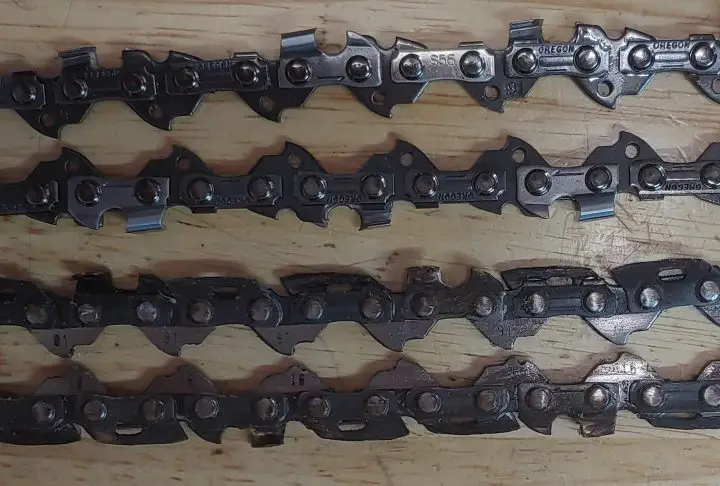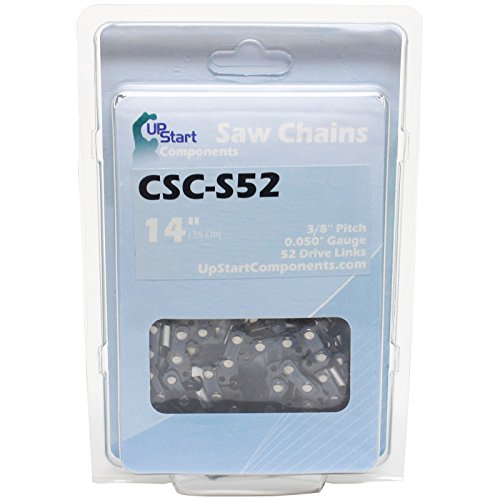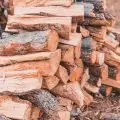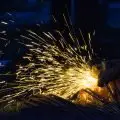In today’s market, there is unlimited availability of chainsaws in a whole variety of sizes, types, and special features.
If you are looking to replace your chainsaw chain, you will need to have all the necessary information about your chainsaw and its chain size or type. With this information, it should be no difficulty to find the right chain.
However, this may become a little more complicated because of the unique way that chainsaw chains are usually measured. Even after matching the right size of chain for your chainsaw, there are still loads of chainsaw chain types, and numerous features that you can choose from.
This article will provide you with all the relevant information on chainsaw chain sizes, along with a full buying guide on all considerations.
Table of Contents
- Chainsaw Chain Size
- Chain-Matching Search Steps
- Chainsaw Chain Considerations
- Types of Chainsaw Chain Explainer Video
- Are Chainsaw Chains Interchangeable?
- FAQs (Frequently Asked Questions)

Chainsaw Chain Size
Before we go into the various types and features of a chainsaw chain, let us look at the measurements, which are absolutely important for matching chainsaw chains.
It is very important to be aware of the three major measurements when it comes to chainsaw chain sizes. These are:
- Pitch measurement
- Gauge measurement
- Number of drive links
Now, let’s take a look at these in more detail!
Pitch Measurement
The pitch measurement of a chainsaw chain is the measurement of how close the links on the chain are to one another. The pitch doesn’t unfortunately describe the total number of links present on the chain; neither does it give details of the total length of the chain if that is what you’re looking for.
Instead, the pitch measurement is half of the distance between any three rivets on the chainsaw chain. Although this measurement is very complicated, most chainsaw manufacturers will display the measurement on the tool for ease. And definitely in the user manual.
Pitch sizes are normally measured in inches, with the following being the most commonly available on chainsaw chains:
- 1/4″
- 0.325″
- 3/8″
- 3/8″ low profile
- 0.404″
The most common of all these pitch sizes is the 3/8 inch pitch chain, followed by the 3/8 inch low-profile pitch chains. These 3/8 inch low-profile chains are designed to allow only a small amount of the material to be cut.
This is primarily due to the kerf, which is the width of material removed during cutting, being very narrow, reducing the power needed for cutting.
The 3/8 inch low-profile chains are typically suitable for chainsaws with guide bars that reach 18 inches maximum. These are the most commonly used chain for light, non-professional application chainsaws like one that a DIYer may own.
The 0.404-inch pitch chain is designed for larger, more professional-grade chainsaws like the ones that are used by professionals such as tree surgeons and firemen. The distance between the links in these designs provides room for far more aggressive cutting.
If the pitch measurement is displayed on the tool, it will usually be on the guide bar and is located around the user-end of the tool. If you’re lucky, the number will be displayed very clearly, but other times it may be jumbled amongst other numbers.
Therefore, you really need to know what you are looking for. If a pitch size number cannot be found on the chainsaw or in the user manual, then it is possible to measure the pitch.
A very high level of accuracy is required when measuring pitch in order to distinguish the difference between certain sizes like 0.325-inch and 3/8 inch, therefore, it is certainly recommended to take the chainsaw chain to an expert for it to be measured.
If you do, however, feel confident in measuring the pitch by yourself, you should always measure between the middle points of 3 rivets on the chain, then divide the result by 2.
For example:
If you measure a 3/8 inch pitch chain, the right measurement between 3 links would be 3/4 inch. When this is divided by 2, you will get your 3/8 inch measurement.
Gauge Measurement
There is a part of the chainsaw chain that fits into the guide bar on the chainsaw, and this is called the drive link, the bottom area of the chainsaw chain.
More about parts of a chainsaw on the blog.
The gauge measurement is the thickness of the drive links when they are looked at along the length of the chain. It is very crucial to make sure that the right chain gauge is matched with the saw so that the chain can fit into the guide bar properly for accurate function.
There are several gauge measurements available for chainsaw chains, all of which are also measured in inches, and they include the following:
- 0.043″
- 0.050″
- 0.058″
- 0.063″
The 0.050-inch is the most common of these gauge measurements. Just as with the pitch measurement, the gauge measurement is often displayed on the chainsaw towards the user-end of the guide bar.
Again, this gauge measurement can either be displayed clearly on the tool or mixed in with a bunch of other numbers. Therefore, it is also very important to know the sort of numbers to look out for.
It is not recommended to measure gauges by yourself as they are very small, and require extreme accuracy. It’s possible to do so if you have an accurate caliper available, otherwise, you should definitely seek professional help.
Number of Drive Links
If the drive link count is not already known, the number of drive links on the chain must be counted to ensure the right chainsaw chain is selected. The overall length measurements of chainsaw chains may not be enough to help you when you need to find the correct chainsaw chain.
The reason for this is that the total length of a chainsaw chain is given as a combination of both the pitch measurement and the number of drive links.
This method is the most accurate and certainly best way for chain manufacturers to keep all the various sizes and types of chains in order.
Unlike the pitch and gauge measurements, the number of links on a chain is typically not displayed on the chainsaw or even in the manual. Hence, why the number of links on a chain must be counted.
Chain-Matching Search Steps
Before you begin a search for the right chainsaw chain, using the information above, you can generate some steps that are important to follow, these are:
- Get the pitch measurement of the chain – find it on the user end of the tool, in the user manual, or by dividing the distance between 3 links on the chain by 2. Though, it is typically recommended that this should be done by an expert in a shop.
- Get the gauge measurement of the chain – this can either be done by finding it on the use ends of the chainsaw, in the user manual, or by measuring the thickness of the chain’s drive links with a very accurate pair of calipers.
- Get the accurate number of each drive link on the chain – count the number of drive links on the chain.
Now, that you have the 3 numbers you can easily purchase the correct chain.
Chainsaw Chain Considerations
After successfully going through the measurement process to get the right chainsaw chain size, you will now have to consider all the other options depending on your preference. Some considerations it’s important to understand include:
- Type of specialty chain
- Chain aggressiveness
- Additional chainsaw chain features
Let’s take a look at each in more detail!
Types of Specialty Chains
Over the years, the creation of several types of chainsaw chains has been designed to accommodate a variety of cutting and sawing techniques, making it possible to be faster, easier, and suited to specific jobs.
There are three very common types of specialty chains:
- Low profile chain
- Narrow kerf chain
- Ripping chain
1. Low Profile Chainsaw Chain
A low-profile chain makes use of cutters that aren’t as tall as the cutters on a standard chainsaw chain. This allows a lightweight low-profile chain will make a shallow cut.
An advantage of these styles of the chain is that they weigh less than a standard chain, making them ideal options for chainsaws that are low-horsepower and electric. The lighter the weight of the chain, the less the strain on the engine.
Generally, low-profile chains are available in a 3/8″ pitch and a .050″ gauge, and they tend to only fit bars that are specifically made to accommodate low-profile chains.
The low-profile chain will not fit or work with chainsaws that have bars that require more than 72 drive links on its chain. Here’s an example of a low profile chainsaw chain on Amazon:
- Replacement Oregon S52 Chainsaw Chain; Quantity: 6 Chains
Prices pulled from the Amazon Product Advertising API on:
Product prices and availability are accurate as of the date/time indicated and are subject to change. Any price and availability information displayed on [relevant Amazon Site(s), as applicable] at the time of purchase will apply to the purchase of this product.
2. Narrow Kerf Chain
As you may have guessed, the narrow Kerf chain has narrower cutters than the standard chain. These chains allow you to get a thinner, narrower cut and remove less wood than a standard chain.
The narrow kerf chain allows the chainsaw user to cut very quickly and to use a long bar with a full-size chain, making it an excellent choice for low horsepower and electric chainsaws.
Some narrow kerf chains may also be low-profile chains that can help you achieve the same lightweight, high-speed cutting experience.
Before you change the chain, always look out for the compatibility of your narrow kerf chain to ensure it matches your chainsaw bar. Here’s an example of a narrow kerf chainsaw chain on Amazon:
- Manufactured with Patented Oregon OCS-01 steel which provides greater durability, especially in cold cutting conditions.The Blued Cutters provide superior corrosion resistance and improved strength.
Prices pulled from the Amazon Product Advertising API on:
Product prices and availability are accurate as of the date/time indicated and are subject to change. Any price and availability information displayed on [relevant Amazon Site(s), as applicable] at the time of purchase will apply to the purchase of this product.
3. Ripping Chain
Both the low profile chain and narrow kerf chain will be able to help you when you need to do standard tasks efficiently. However, if you have heavy-duty tasks such as milling logs into wood planks, you will need to use the ripping chain.
The cutters on the ripping chain are able to cut at angles lower than those on standard chainsaw chains, about 10 degrees compared to the standard 30 degrees.
The ripping chain cuts along the wood’s grain, unlike the standard chains that cut against the grain of the wood. Therefore, the ripping chain is capable of removing smaller chunks of wood far less aggressively.
This feature certainly makes it the optimum choice for creating finer cuts and smooth planks, hence why its price is typically quite high. Here’s an example of a chainsaw ripping chain on Amazon:
- 72rd: 3/8-inch pitch, 050-inch gauge
Prices pulled from the Amazon Product Advertising API on:
Product prices and availability are accurate as of the date/time indicated and are subject to change. Any price and availability information displayed on [relevant Amazon Site(s), as applicable] at the time of purchase will apply to the purchase of this product.
Types of Chainsaw Chain Explainer Video
Here’s another useful video with some more detailed explanation on the difference between different chainsaw chains.
Chain Aggressiveness
Chain Aggressiveness is a very another important feature you must consider before you purchase a new chainsaw chain. This fracture comes in three different levels or degrees:
- Low-kickback/anti-kickback
- Regular (skip-tooth)
- Aggressive (full-skip)
1. Low-Kickback/Anti-Kickback
Most chainsaw chains are designed to have low-kickback or anti-kickback features in order to help reduce the risk of kickback-related accidents.
Kickback is a phenomenon that happens when the upper nose of your chainsaw guide bar makes contact with the material you are cutting during operation. The aim is to avoid a situation where the upper part of the chainsaw makes contact with the material, causing an increased force to throw the chainsaw back.
This area of the chainsaw is known as the kickback danger zone. Some accidents have ended up putting users in hospital, hence the importance of this feature.
In addition to this, manufacturers have designed caution information to help their users avoid damage or injuries. Online stores will often provide caution information that appears at the top of their “chainsaw chains” accessories page to help protect their users from accidents.
Unfortunately, many chainsaws lack kickback protection and are only designed for professionals and experts. Therefore, if you have not received any specialized training for kickback control and prevention, you should only be looking to purchase chainsaws with the “Low Kickback” feature to help prevent injury or accidents.
However, low-kickback chains often limit the amount of material being cut and can be very time-consuming. Hence, the cutting proceeds at a slower pace than with the more aggressive chains.
2. Regular Chains (Skip-Tooth)
Regular, or skip-tooth, chains are usually made to have a one-link space between each cutting tooth for lower resistance, and faster and grittier cutting abilities.
If the manufacturers do not list your chain as a low-kickback chain, a full-skip, or as having some other special feature, then it is more than likely a regular skip-tooth chain. These types are often used for numerous professional operations.
3. Aggressive (Full-Skip)
A full-skip chain is designed by spacing two links between each cutting teeth, allowing for a really low-resistance cutting. These chain types are usually for saws that have guide bars at least 24 inches.
Users will need to be trained properly for this length and aggression, however, users often enjoy the extra length of this type because you will not need to bend down in order to reach the work area.
However, asides from their special convenience, these chains are often for trained and professional users, and a lot of regular chainsaw homeowners will not have applications that require this type of chain.
Additional Chainsaw Chain Features
On top of the two previously described considerations, there are several other chainsaw chain features available that are equally important.
These additional features include:
- Self-sharpening chains
- Built-in lubrication
- Low-vibration chains
- Carbide chains
1. Self-Sharpening Chains:
Self-sharpening chainsaw chains are designed with teeth that file themselves as the chain passes around the guide bar.
Sharpening is said to be one of the biggest maintenance problems that chainsaw users often face, and it is usually advised to seek professional help to ensure the blades aren’t ruined.
Therefore, a self-sharpening chain will actually help you to reduce the costs of the trips to a chainsaw store. However, it is important to understand that this feature does not always sharpen the chain exactly how you want it, and you will get a better result from a store.
It is advised that the teeth are occasionally manually touched up first, before needing to get regular sharpening maintenance. All in all, the self-sharpening chain feature will help to make sure the chain remains sharp for an extended period.
2. Built-In Lubrication:
Chainsaws are designed to have many built-in design features that would help keep the chains lubricated throughout their operation. These features tend to include grooves and holes in the cutting links which ensure the lubricant stays on the chain during the cutting process.
For any tool that moves, constant lubrication is an essential maintenance process. Therefore, this is an important consideration, to make sure your chainsaw remains lubricated without you having to do a lot of work.
3. Low-Vibration Chains:
Both chainsaws and their chains have vibration ratings provided by standardized testing. These ratings are very important because constant use of any vibrating tool, like chainsaws, can cause serious health dangers to the hands or elbow. These dangers include:
- Pain
- White finger syndrome
- Numbness
- Burning sensation
In order to tackle this problem, many chain manufacturers will provide specific design features that can help to greatly reduce vibration, and ultimately the risk of any associated health problems.
They are able to accomplish this by creating a space between the chain and the guide bar, which essentially acts as a resistance against friction, thereby reducing vibration.
Chainsaw vibration will not be of much concern to users who are only operating their chainsaws for occasional tasks. However, if you’re using the saw as part of your daily routine, then a low-vibration chain is essential.
4. Carbide Chains:
Carbide is an extremely hard and durable material. However, it is also quite brittle, meaning that it can shatter if it is struck with force. There are a number of certain chainsaw chains which are made with carbide.
These chains are designed to have greater durability, especially in cutting situations that would normally quickly wear out a normal chain.
The thing is, these chains are generally at a greater cost when compared to the normal ones. Therefore, they are usually only considered for operations in the dirt, sand, cold weather, and other extreme conditions that would cause wear to a normal chain.
Although carbide chain has greater durability so can keep the chain sharp for longer periods and help to prevent wear, they are also usually less sharp and slower during overall cutting.
Are Chainsaw Chains Interchangeable?
There is no simple answer to this question. Whether or not the chainsaw bars you’re planning to purchase will be interchangeable, will depend on several factors, which include the model of chainsaw that you have, the size of the bar, and more.
It’s easy to assume that you probably won’t take a particular brand of chainsaw and use a bar from another brand on it. However, you may be able to use a universal chainsaw bar, that is, one that is not related to a name brand but can still satisfy your requirements.
Even after finding a universal chainsaw bar, there are still certain things that you have to consider for you to determine if the chains are interchangeable or not. These include:
- The size: If you are going to be using the same chain for two different chainsaws, they must be the exact same size.
- The tensioner hole: Chainsaws often have a tensioner hole that allows you to adjust the tension of the chain on the bar. Does yours?
- There are also oil holes that are present in some models of chainsaws.
All of these features must be identical on both chainsaws for you to be able to use the chain bar interchangeably.
So, if the sizes are not the same, if the tensioner hole on your chainsaws does not line up, or if the bolt slot is not placed at the same length on both of the chainsaws, it simply will not be interchangeable.
If you are sure that all these features match perfectly, then you can remove the chain on one chainsaw and place it on the other one.
Make sure the chainsaw operates as it should before concluding. If your chainsaw does not experience any problems, then you will know for certain that you can use that same chain on both chainsaws.
FAQs (Frequently Asked Questions)
How do I know the size of my chainsaw chain?
To get the correct size of your chainsaw chain in terms of pitch, simply count 3 rivets on the chain and measure the distance between them from their center points. Then you need to divide this by two to get your size. For example, three rivets that measure ½ an inch across divided by two, will give you a pitch of a ¼ inch.
What is the most common chainsaw chain size?
The most common pitch size is the 3/8 inch pitch chain, followed by the 3/8 inch low-profile pitch chain. In terms of gauge measurement, the 0.050-inch is the most common.








